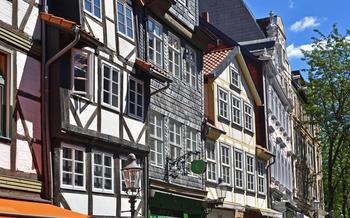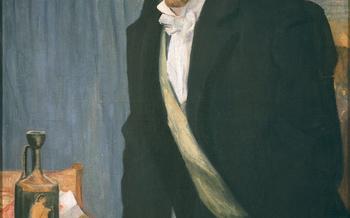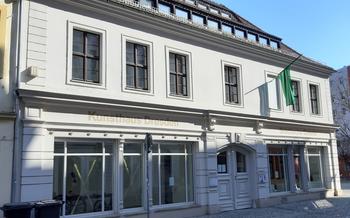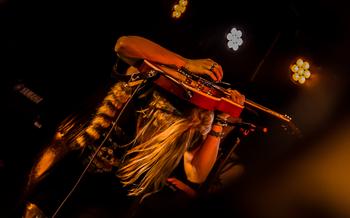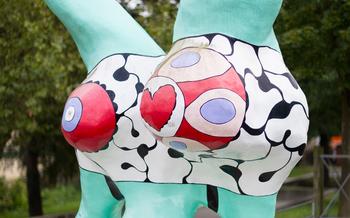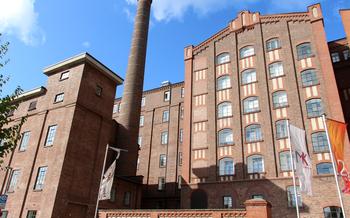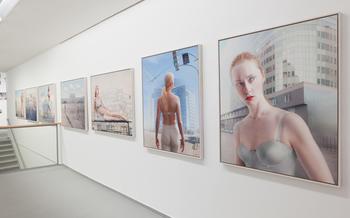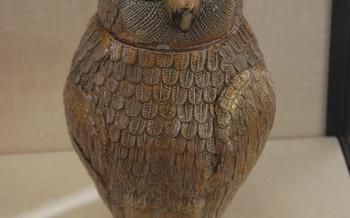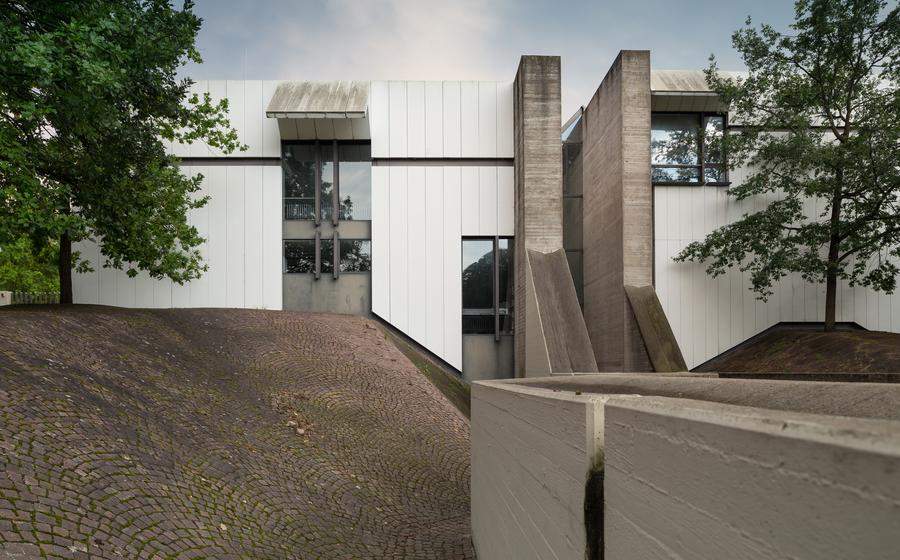
Sprengel Museum
- The Sprengel Museum: A Cultural Gem in Hanover
- Masterpieces of the Collection
- Expressionist Art: A Highlight of the Museum
- Niki de Saint Phalle's Nana Sculpture: A Symbol of Female Empowerment
- Paul Klee's Paintings: A Journey into Abstraction
- Interactive Workshops and Educational Programs
- Architecture and Design of the Museum
- Special Events and Exhibitions
- Guided Tours and Audio Guides
- Museum Shop and Café
- Accessibility and Visitor Information
- Location and Transportation
- Combination Tickets and Discounts
- Insider Tip: Hidden Gems of the Collection
The Sprengel Museum: A Cultural Gem in Hanover
Nestled in the heart of Hanover, Germany, the Sprengel Museum stands as a testament to the city's vibrant art scene and cultural heritage. Founded in 1979, the museum has become a renowned institution, housing an extensive collection of modern and contemporary art that spans the 20th and 21st centuries.
The Sprengel Museum is not just a repository of artworks; it's a place where art comes alive, where creativity and innovation converge. With its unique architectural design, the museum creates an immersive environment that complements the diverse collection within its walls.
The Sprengel Museum's architectural masterpiece is a reflection of its commitment to contemporary art. Designed by architects Peter and Ursula Trint, the building is a symphony of geometric forms and natural light, creating an atmosphere that enhances the artworks on display. The interplay of light and space transforms the museum into a dynamic canvas, where art and architecture dance together.
Masterpieces of the Collection
The Sprengel Museum houses a remarkable collection of modern and contemporary art, featuring a diverse range of artistic styles and genres. Among the highlights of the collection are masterpieces by renowned artists such as Pablo Picasso, Wassily Kandinsky, Joan Miró, and Ernst Ludwig Kirchner. Picasso's "Woman with a Hat" is a striking portrait that exemplifies his mastery of Cubism, while Kandinsky's "Composition VIII" showcases his pioneering exploration of abstract art. Miró's playful and surrealist painting "Woman with a Bird" captures the artist's unique visual language, and Kirchner's vibrant expressionist masterpiece "Street, Berlin" offers a glimpse into the tumultuous urban life of early 20th-century Germany. These iconic works, along with many others, form the cornerstone of the Sprengel Museum's exceptional collection, offering visitors a journey through the history of modern art.
In addition to these established masters, the museum also showcases the works of emerging and contemporary artists, ensuring a dynamic and ever-evolving collection. Temporary exhibitions and special displays complement the permanent collection, providing visitors with the opportunity to discover new artistic voices and engage with current trends in contemporary art.
Expressionist Art: A Highlight of the Museum
The Sprengel Museum houses a remarkable collection of Expressionist art, a movement that emerged in Germany in the early 20th century. Expressionist artists sought to convey emotional experiences and subjective realities through bold colors, distorted forms, and intense brushstrokes.
Among the highlights of the Expressionist collection are paintings by Ernst Ludwig Kirchner, a founding member of the Brücke group, known for his vibrant urban scenes and portraits. Erich Heckel, another Brücke artist, is represented with works depicting landscapes and everyday life. Karl Schmidt-Rottluff, whose expressive woodcuts are characterized by strong lines and geometric forms, is also well-represented.
The museum also features sculptures by Wilhelm Lehmbruck, whose elongated, graceful figures explore themes of human emotion and suffering. Emil Nolde, known for his passionate and colorful landscapes and religious works, is represented with several paintings in the collection.
These Expressionist works offer a glimpse into the tumultuous and transformative period of German art and history. They challenge traditional notions of representation and invite viewers to engage with the emotions and experiences of the artists themselves.
Niki de Saint Phalle's Nana Sculpture: A Symbol of Female Empowerment
Among the highlights of the Sprengel Museum's collection is Niki de Saint Phalle's iconic Nana sculpture. Standing tall and proud, this vibrant and voluptuous figure embodies the artist's celebration of femininity and female empowerment. Created in the 1960s, the Nana series marked a significant departure from de Saint Phalle's earlier work, characterized by her use of explosive techniques and assemblages.
With their curvaceous forms, bright colors, and playful expressions, the Nanas exude a sense of joy, confidence, and freedom. The Sprengel Museum's Nana, crafted from brightly painted polyester resin, is a particularly striking example of this series. Positioned prominently within the museum's galleries, the sculpture invites viewers to engage with its bold presence and message of female liberation.
De Saint Phalle's Nanas were not merely aesthetic creations; they carried a deeper political and social significance. Through these sculptures, the artist challenged traditional representations of women in art, which often objectified and marginalized them. The Nanas, with their exaggerated features and defiant postures, celebrated the strength, diversity, and sensuality of women, challenging prevailing societal norms and stereotypes.
As a pioneering figure in the feminist art movement, Niki de Saint Phalle used her art to empower women and promote gender equality. Her Nanas, including the one showcased at the Sprengel Museum, stand as powerful symbols of this struggle, reminding viewers of the importance of embracing and celebrating the unique beauty and power of every woman.
Paul Klee's Paintings: A Journey into Abstraction
Paul Klee, a Swiss-German artist, is renowned for his unique artistic style that blended abstraction, surrealism, and symbolism. The Sprengel Museum houses a notable collection of Klee's paintings, offering visitors a comprehensive insight into his creative journey.
Among the highlights of the collection is "The Twittering Machine," created in 192This whimsical painting showcases Klee's playful experimentation with form and color, depicting a fantastical bird-like machine amidst a vibrant landscape.
Another masterpiece is "Senecio," painted in 1922, which exemplifies Klee's interest in nature and organic forms. The painting features a delicate plant-like figure rendered in soft, muted colors, evoking a sense of tranquility and growth.
Klee's unique techniques, such as his use of grids and geometric shapes, are evident in works like "Composition with Red and Green" (1923). This painting showcases his ability to create harmonious compositions while exploring the interplay of colors and forms.
Through these remarkable paintings, the Sprengel Museum offers visitors a profound understanding of Paul Klee's artistic vision and significant contributions to the development of modern art.
Interactive Workshops and Educational Programs
The Sprengel Museum offers a diverse range of educational programs and interactive workshops designed to foster art appreciation and creativity among visitors of all ages. These programs provide a unique opportunity to engage with the museum's collection, explore artistic techniques, and unleash your own creative potential.
Children and adults alike can participate in hands-on workshops led by experienced educators. These workshops cover a variety of topics, from painting and drawing to printmaking and collage. Participants can experiment with different materials and techniques, learn about the work of renowned artists, and create their own unique artworks to take home.
The museum also organizes regular events, workshops, and performances that delve deeper into specific aspects of art and culture. These events may include lectures by art historians, gallery talks by curators, film screenings, and live performances by musicians, dancers, and theater companies.
The Sprengel Museum's educational programs and interactive workshops not only enhance the visitor experience but also play a crucial role in promoting art education and fostering a vibrant cultural community in Hanover.
Architecture and Design of the Museum
The Sprengel Museum stands out not only for its impressive collection but also for its striking architectural design. Designed by renowned architects Peter and Ursula Trint, the museum building is a masterpiece of modern architecture. Its unique features include a glass facade, curved walls, and a central atrium that floods the galleries with natural light. The building's design reflects the museum's focus on contemporary art, emphasizing openness, transparency, and a dynamic relationship between interior and exterior spaces. The architects' vision was to create a space that would inspire visitors and provide an immersive experience of modern and contemporary art. The result is a building that is both functional and aesthetically pleasing, seamlessly blending form and function to create a memorable cultural landmark in Hanover.
Special Events and Exhibitions
The Sprengel Museum is not just a static repository of art but a vibrant hub of cultural activity. Throughout the year, the museum hosts a diverse range of special events, workshops, and performances that bring art to life and engage visitors in new and exciting ways.
Regular workshops and lectures invite artists, curators, and experts to share their knowledge and insights on various aspects of modern and contemporary art. These events provide an opportunity for visitors to delve deeper into the creative processes, inspirations, and historical contexts behind the works on display.
The museum also organizes temporary exhibitions that showcase contemporary art from around the world. These exhibitions often feature emerging artists, cutting-edge installations, and innovative artistic practices. By presenting these temporary shows, the Sprengel Museum stays at the forefront of contemporary art discourse and offers visitors a glimpse into the latest developments in the art world.
Collaborations with other cultural institutions, such as theaters, music venues, and universities, further enrich the museum's program. These collaborations result in interdisciplinary events that combine art with music, performance, and film, creating a truly immersive and multisensory experience for visitors.
Guided Tours and Audio Guides
The Sprengel Museum offers guided tours in various languages, providing visitors with a deeper insight into the museum's collection and history. These tours are led by experienced art historians who share their knowledge and expertise, enhancing the visitor's understanding of the artworks. Guided tours are ideal for groups or individuals seeking a more in-depth exploration of the museum.
For those who prefer a more independent experience, the museum provides informative audio guides. These audio guides are available in multiple languages and offer a self-guided tour of the collection. Visitors can listen to detailed commentaries on selected artworks, providing them with a personalized and enriching experience. The audio guides are easy to use and allow visitors to explore the museum at their own pace.
Museum Shop and Café
The Sprengel Museum offers a well-stocked museum shop where visitors can find a diverse selection of art-related items. From catalogues and art books to prints and posters, the shop provides a range of souvenirs and keepsakes that celebrate the museum's collection and exhibitions. Visitors can also purchase unique handmade crafts, jewelry, and accessories inspired by the works of art on display.
Adjacent to the museum shop is a cozy café that invites visitors to relax and socialize while enjoying refreshments and light meals. The café serves a variety of hot and cold beverages, including coffee, tea, and fresh juices. Visitors can choose from a selection of sandwiches, salads, and cakes, all prepared with fresh, local ingredients. The café's outdoor terrace offers a pleasant setting to savor a cup of coffee or a light lunch while enjoying the views of the surrounding gardens.
Accessibility and Visitor Information
The Sprengel Museum welcomes visitors from all backgrounds and abilities. Accessibility features are in place to ensure that everyone has a comfortable and enjoyable experience. Wheelchair ramps, elevators, and accessible restrooms are available throughout the museum, making it easy for visitors with disabilities to navigate the galleries.
The museum staff is friendly and multilingual, always ready to assist visitors with any questions or needs. Information desks are located at the entrance and throughout the museum, providing maps, brochures, and guides in multiple languages. For those who prefer a more in-depth exploration, guided tours in various languages are offered regularly, providing insights into the museum's collection and history.
The Sprengel Museum also caters to groups and school visits. Guided tours tailored to specific interests and educational levels can be arranged in advance. Workshops and interactive programs are available for school groups, encouraging students to engage with art in a hands-on manner. The museum's educational department collaborates with teachers to develop customized programs that align with school curricula.
To make the most of your visit, plan your trip in advance. Check the museum's website for current exhibitions, events, and educational programs. Online ticketing is available, allowing you to skip the queues and secure your entry. The Sprengel Museum is a place where art and inclusivity converge, ensuring that everyone has the opportunity to appreciate and engage with the masterpieces within its walls.
Location and Transportation
The Sprengel Museum is conveniently situated in the heart of Hanover, making it easily accessible for visitors. The museum's central location allows for a seamless integration into your exploration of the city's cultural offerings. Whether you're a local resident or a tourist, reaching the museum is a breeze.
Multiple public transportation options are available to take you directly to the museum's doorstep. The nearest bus stop, "Sprengel Museum," is just a short walk away, connecting you to various bus lines. For those arriving by train, the Hanover Hauptbahnhof (main train station) is within easy walking distance, offering a convenient connection to regional and national rail services.
If you prefer the flexibility of driving, the museum provides ample parking facilities nearby. Several parking garages and on-street parking options are available in the vicinity, ensuring a hassle-free visit. Choose the transportation method that suits your preferences and immerse yourself in the artistic treasures that await you at the Sprengel Museum.
Combination Tickets and Discounts
Visiting the Sprengel Museum offers excellent value for money, especially with the various discounts and combination tickets available. Students, seniors, and groups can take advantage of reduced admission prices, making art accessible to a wider audience. Additionally, the museum participates in the Hannover Card program, which provides free or discounted admission to many cultural attractions in the city. By purchasing a Hannover Card, visitors can save money while exploring the vibrant art scene of Hanover.
To further enhance the museum experience, combination tickets are available that include admission to multiple attractions in Hanover. These tickets offer a convenient and cost-effective way to explore the city's cultural offerings. For example, visitors can combine a visit to the Sprengel Museum with a trip to the nearby Kestner Museum, which houses a collection of applied and decorative arts. By taking advantage of combination tickets and discounts, visitors can maximize their experience and explore the rich cultural heritage of Hanover without breaking the bank.
Insider Tip: Hidden Gems of the Collection
Beyond the renowned masterpieces, the Sprengel Museum holds a treasure trove of lesser-known gems waiting to be discovered. In a quiet corner of the museum, visitors may stumble upon a mesmerizing painting by Lyonel Feininger, capturing the essence of the Bauhaus movement with its geometric precision and vibrant colors. Another hidden gem is a delicate sculpture by Käthe Kollwitz, conveying a poignant narrative of human suffering and resilience. For those who venture off the beaten path, the museum reveals its secrets, offering a glimpse into the diverse and multifaceted world of modern and contemporary art.
